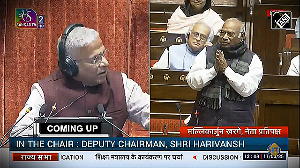Returning to his role as the chief executive officer of global PC manufacturer Lenovo after four years, Yang Yuanqing says "one can never miss this market (India)". The personal computer (PC) maker, which currently ranks fifth in India, is planning to replicate its China success here.
The highest decision making committee of the firm - including Chen Shaopeng, senior VP, emerging markets, Amar Babu, MD Lenovo India and product heads of the ThinkPad and Idea brands - was in India to deliberate their strategy. Speaking to Shivani Shinde, they shared their thoughts. Excerpts:
What's your agenda here?
Yang: India is a very important market for Lenovo. Our visit, the first by many of us (his first as CEO too), reconfirms our commitment to India as a market. This also gives us an opportunity to understand the culture of the country.
We have recently had a new corporate structure. Wherein, the sales and marketing is divided into two geographies, Emerging (consisting of India, China, Eastern Europe, Africa and Russia) and developed markets like North America, Australia, Western America and Japan.
Moreover, the product business will also have two groups i.e. ThinkPad and Idea. We want to target this high growth opportunity.
We have three core features. First, we have a unique dual business model that allows us to work with both enterprise and government and small and medium enterprises and consumers. Two, the linear cost structure and, finally innovation has been key to us.
Please elaborate your strategy for India.
Chen Shaopeng: We have a half-moon strategy, where China is at the centre and we will leverage our position and target regions like India, Eastern Europe, Africa, Russia and others. We will adapt to the local context and have a marketing strategy accordingly and, finally, focus on the supply chain and increasing our channel initiatives.
There are a number of key initiatives for India. First, we will speed up product availability in the market. We want to and will get products and offering to the Indian market much faster than our competitors. The second will be products where we will have much broader product portfolio. Third, we will have a growth strategy related to our partners, and increase our channel partnership.
Yang: The other focus will be building a team that will lead this. We have that in place. But I would like to build an ownership culture in the firm. Though it is a legacy from IBM, somehow it was not built on. Besides, product portfolio is important.
You said the focus will be more on transaction customers. Kindly comment.
Yang: There is a shift in the market from relationship customers (enterprise and government) to transactional customers (SMEs and individual customer). Rather, the transactional market has grown faster than the relationship market. We will focus on both the markets.
Because of the IBM legacy, we have had a strong position in the enterprise segment and we want to increase our penetration into the consumer segment. Rather, India was the first country where Lenovo launched its consumer business products three years ago. Lenovo has a manufacturing plant in India in Pondicherry with a capacity of 3 million units. Annually, the firm has sale of half-a-million units in India.
How do you plan to position the brand Lenovo?
Yang: We have products catering to both the premium and enterprise segment, as well as the consumer segment. Our ThinkPad products, which has premium brand image, will extend to an enterprise segment to the high-end SME segment. Whereas our 'Idea' products will cater to mainstream SME and consumers.
Amar Babu: We have recently launched seven new products for the Indian market. We will cater to various price points. The notebook segment starts from Rs 22,000 to Rs 70,000. In desktop, we have a price range from Rs 21,000 to Rs 65,000.
How do you plan to target the SME segment?
Amar Babu: We have a presence in 350 cities in India, but this is clearly not enough. We have an immediate goal to reach all the 500 districts in India by this year-end. That is why we are making channels as core to our growth strategy in India.








 © 2025
© 2025